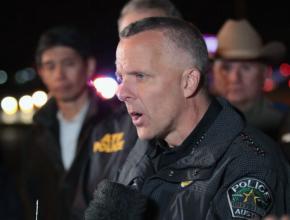The truth about Austin’s terrorist bomber
writes from Austin about the gaping questions about both the villains and supposed heroes in the series of bombings that struck fear into the community.
ON MARCH 21, residents of Austin, Texas, learned that 23-year-old Mark Conditt, suspected of carrying out a series of bombings that terrorized the city, killed himself by detonating an explosive as police approached him in his parked vehicle.
A traumatized public, afraid for three weeks to leave their homes or receive packages, were desperate for answers: Who, what, why?
Not only have there been no satisfactory answers, but worse, the response from authorities and the media--once suspicion centered on a young white man--has been shockingly empathetic toward the suspected bomber.
The first two victims of the bombings were African Americans--39-year-old Stephan House and 17-year-old Dralen Mason, a high school senior and talented musician who would have learned, had he lived a few days longer, that he had been accepted to study next school year at the prestigious Oberlin Conservatory of Music.
The third victim, Esperanza Herrera, was severely injured by another exploding package that was possibly meant for a member of another African American family.

Later bombings weren't as specifically targeted, but the connections of the actual and intended victims of the first explosions led to the obvious conclusion that the bombings were motivated by racist hate--though when House was killed by the first bomb, police reportedly suspected he had built it himself and didn't investigate the explosion as a homicide.
Later in the day after Conditt killed himself, it was revealed that he left behind a 25-minute phone "confession," giving explicit details about each of the bombs. Interim Austin Police Chief Brian Manley gave no other details than that the tape "is the outcry of a very challenged young man talking about challenges in his personal life that led him to this point."
This response infuriated the public, which demanded real answers and the release of the tape.
Racism was an obvious motive for the bombings, not only because the first three victims were minorities, but because of Austin's long history of segregation and racial tensions.
The now continually congested Interstate 35 that runs through Austin was constructed to divide the eastern part of the city where people of color were segregated from the whites on the west. Recently, a population boom has made residency on the east side trendy and affordable, while old-time residents are being pushed out.
Under pressure to admit that Austin's serial bomber was a domestic terrorist, Chief Manley finally did so only long after the fact.
WHAT DO we know about the "very challenged young man talking about challenges in his personal life," as Chief Manley described Conditt last month?
The only statements from family members came from relatives in Colorado, who described them as "a normal family in every way," despite all the evidence to the contrary.
But 24-year-old Jeremiah Jensen, who had shared church activities with Conduit and his family, described visits to the Conditt home for lunch, Bible study and gunplay--not really "normal in every way."
Jensen and Conditt were involved in an outdoors group for home-schooled kids with the name "RIOT--Righteous Invasion of Truth." The Christian survivalist group engaged in Bible study, archery and gun skills.
Conditt attended Austin Community College for a couple of years, but didn't graduate. A blog titled "Defending My Stance" that he wrote for a government class project gives more insight into what motivated him. In it, Conditt denounced LGBT people and supported prohibiting gay marriage. He had a negative view of women, opposed abortion and was pro-death penalty.
A neighbor of the Conditts who didn't want to be identified told the Houston Chronicle that the family was very conservative and evangelical--an "us versus them type of household."
Many people shied away from identifying Mark Conditt with white supremacy and bigotry--Jeremiah Jensen speculated that his former friend's actions had more to do with "loneliness and anger" than being a "conservative terrorist."
But what we know about Conditt is not so very different from the political views of Religious Right political leaders like Mike Pence and the other Tea Partiers in Congress. Yet none of this has been stated by authorities.
AFTER THE nightmare in Austin ended with Conditt's death, praise was heaped on the Austin police and the FBI for their investigation of the case and pursuit of the suspect.
Demands for the release of Conditt's "confession" seem to have vanished. So, too, have criticisms of Austin police for their slow response when the bombings involved Black and Brown people. Instead, City Council members and other officials are clamoring to make interim police chief Brian Manley's status permanent.
The police department's well-documented history of racial profiling and its record of killing unarmed Black citizens shouldn't be ignored.
Ironically, Drylen Mason, the young musician killed by Conditt, wrote an award-winning essay a few years earlier on the topic of "What is the most important issue facing your community?"
His answer, at age 13, was racial profiling by the Austin Police Department.
Before the commendations get handed out for stopping the Austin bombings, it would be worth reflecting on Draylen Mason's words.


